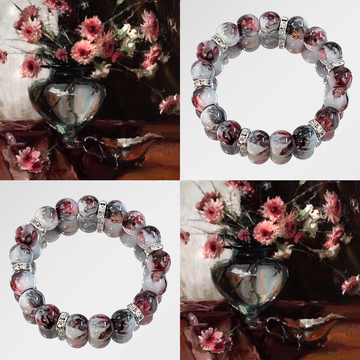The Fluorescent Properties of Fluorite Bracelets and Concerns About Radiation
Fluorite, a calcium fluoride mineral, is renowned for its striking fluorescence under ultraviolet (UV) light, a trait that has made it a favorite among collectors and jewelry enthusiasts. This natural phenomenon, combined with its vibrant color range, gives fluorite bracelets a unique appeal. However, questions about radiation safety often arise due to the mineral’s composition and historical associations. Below, we explore the science behind fluorite’s fluorescence and address common concerns about its potential radiological impact.
The Science Behind Fluorite’s Fluorescence
Fluorite’s ability to glow under UV light stems from its crystal structure and the presence of trace elements. When exposed to ultraviolet radiation, electrons within the mineral’s calcium fluoride lattice absorb energy and jump to higher energy states. As these electrons return to their ground state, they release energy in the form of visible light, creating the characteristic glow.
The color of fluorescence varies depending on impurities. For example, europium (Eu) and yttrium (Y) are common activators that produce blue or violet hues, while manganese (Mn) can result in orange or yellow fluorescence. Some specimens may even exhibit multiple colors due to varying impurity concentrations, adding to their visual complexity. This natural light show makes fluorite bracelets particularly captivating under blacklight.
Natural Radiation in Fluorite: Sources and Levels
Fluorite itself is not inherently radioactive, but certain deposits may contain trace amounts of radioactive elements like uranium (U) or thorium (Th). These impurities can occur when fluorite forms in hydrothermal veins alongside radiogenic minerals. The presence of uranium, for instance, might lead to faint radioactivity, though the levels are typically extremely low—often below detectable limits for standard Geiger counters.
Most commercially available fluorite undergoes testing to ensure it meets safety standards for jewelry use. Radiation exposure from wearing a fluorite bracelet is negligible compared to natural background radiation, which includes cosmic rays and terrestrial sources like radon gas. However, prolonged handling of untested, raw fluorite specimens from high-risk deposits could pose minimal risks, emphasizing the importance of sourcing from reputable suppliers.
Historical Context: Fluorite and Radium Contamination
The confusion around fluorite’s radiation stems partly from historical misuse of radium-doped materials. In the early 20th century, some manufacturers added radium to fluorite or other minerals to enhance fluorescence for novelty items like glow-in-the-dark dials. These products posed significant health risks due to radium’s alpha radiation, which can damage living tissue.
Modern fluorite jewelry has no connection to these practices. Today’s specimens are sourced from natural deposits and processed without artificial enhancements. Any residual radioactivity in natural fluorite is orders of magnitude weaker than historical radium-treated materials, making contemporary bracelets safe for everyday wear when properly vetted.
How to Identify Safe Fluorite for Jewelry
To ensure a fluorite bracelet poses no radiological concerns, look for stones that have been certified by gemological laboratories or reputable dealers. These sources typically test for radioactivity and disclose any treatments. Natural fluorite from non-radiogenic regions, such as China, Mexico, or the United States, is less likely to contain significant impurities.
Visual cues can also offer reassurance. Fluorescent brightness under UV light does not correlate with radiation levels; in fact, highly radioactive specimens often appear dull or non-fluorescent due to structural damage from alpha decay. A vibrant, consistent glow under blacklight is more indicative of a safe, well-formed crystal.
Fluorite’s fluorescence is a testament to nature’s ability to create beauty through physics, while its radiation risks are largely a relic of the past. By understanding the mineral’s properties and sourcing responsibly, enthusiasts can enjoy fluorite bracelets without compromising safety. Whether admired for their glow or their geological history, these stones continue to fascinate as both scientific marvels and artistic expressions.







